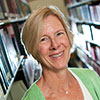This article is more than 5 years old.
An early direct flight (who knew they still exist?) landed Erik and me in Cincinnati before breakfast. The trip began with a most interesting shuttle trip from the airport where the driver (who was about 80), immediately took us off the interstate onto a scenic mountainous, winding, trecherous road that followed the Ohio River on the Kentucky side. We traveled through 5 different little river towns, and were treated to a running travelogue, complete with jokes. The conference didn’t start until after lunch, and neither of our rooms were ready, so we set off to explore the downtown Cincinnati area. We found a suspension bridge designed by the engineer who used it as a prototype for the Brooklyn Bridge, an unusually shaped condominum building designed by Daniel Libeskind, the architect doing the World Trade Center, and a very lovely riverfront park at Sawyer Point.
After lunch, it was down to business, however, it was a bit disorienting to be at a techie conference that doesn’t provide any wireless options, free or otherwise. For the LITA bloggers they had a table set up at the rear of the room that was hard wired!
The opening keynote, by Tim Spaulding from LibraryThing was interesting mainly because I have never used or explored it. He has taken his product to a high level social experience with social cataloging. He told the audience that LibraryThing is now larger than LOC, but allowed that LOC doesn’t have 256 different JK Rowling titles (which is a prime example of the outcome of democracy of social cataloging to me). He spent quite awhile discussing the tagging in LibraryThing. There are 41 million tags now. There are tag mirrors (which shows what tags other people have placed on the books in your catalog), Tag Mash (which combines individual tags for a most exact hit on the meaning: ie romance zombies), and a common knowledge feature that captures things a tradition catalog wouldn’t: who are the most important characters in the book).
The first concurrent session I attended was given by two women (Gretchen Gueguen and Ann Hanlon) who worked with the digitization initiatives at University of Maryland (and knew Jennifer Roper). Neither is still at UMd and one of them (Gretchen) is now at East Carolina. Their talk was “Crowdsourcing Digitization: Harnessing Workflow to Increase Ouput.” They talked about the issues they faced getting Maryland’s large scale, decentralized scanning initiatives under control. They faced many of the types of decisions that we have been faced with in our Digital Forsyth project. The “crowdsourcing” idea speaks to their decision to go with the “wisdom of crowds”, in this case that of patrons and co-wokers. Utimately, they moved to a user driven model to direct their selection of what to digitize rather than preselecting “trophy” collections to showcase. This means they are digitizing those materials that are requested by patron researchers rather than digitizing and then hoping folks will use what they digitize. Now that Gretchen has moved to East Carolina, they are doing the same approach. She showed a screenshot of Joyner’s forthcoming newest collection that contains many of the same features you see in Digital Forsyth including tag clouds and facets. It would be worthwhile to plan a field trip to exchange ideas, don’t you all think?
I joined Erik for the second concurrent session on “Reswizzling the IT Enterprise for the Next Generation” where NC State’s Maurice York talked about how they have restructured their IT operation to be more effective to their customers (over 250 staff with over 700 computers to manage, plus all the servers, services etc. you might expect from NC State). We were both tickled to hear Maurice talk about instituting Service Level Agreements, much like our WFU friends in IS are doing. I wish him luck with that one. The main value of this session for me was that it affirmed that, even on our smaller scale operation, we face the same complexities and challenges to properly serve all of our customers and manage your expectations. There were some good ideas that Erik and his group might try as more and more projects and technologies come our way!
The day ended with a “vendor showcase” reception. LITA has a very small vendor presence compared to many other conferences (maybe 6-8 tables), but there was good conversation between colleagues and roasted veggies, mashed potatoes (a strange addition to an appetizer type party) and other good food.
Today, our presentation is right after lunch, so we’ll report back this evening on how that went!


1 Comment on ‘Friday at LITA in Cincinnati’
Hope your presentation went well!